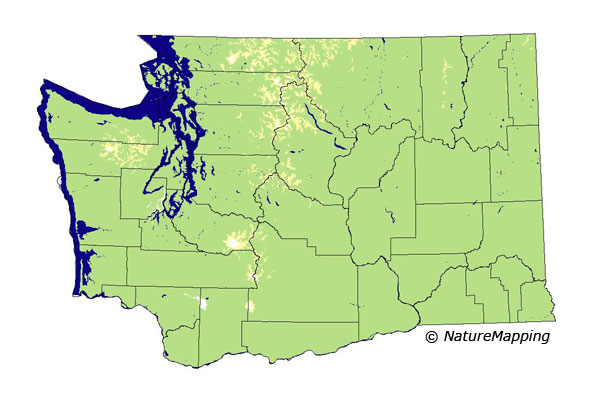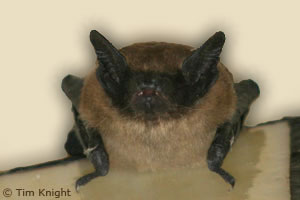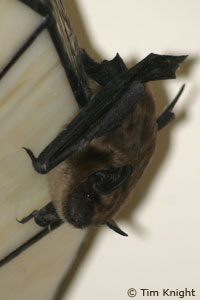


Big Brown Bat (Eptesicus fuscus) Description: Relavitely large flying mammal; brown above with paler belly. Total length: 10-13 cm; tail: 4-5 cm; mass: 13-18 g. The bat's naked parts of the face, ears, wings, and tail membrane are all black (see photos). 
Range: One of the most versatile of all bats, the Big Brown Bat is found in all 48 continental states though it is more abundant in hardwood forests than in coniferous forests. Habitat: This species is common in wooded areas including parks where insects are abundant. The big brown bat inhabits cities, towns, and rural areas. Some bats roost under the bark of trees, other species use old mines, bridges, or caves for roosting. Diet: Insectivore. Their diet consists of flying insects including moths, flies, wasps, flying ants, lacewings, and dragonflies. 
Some bat species in other countries eat fruit, nectar or fish. Vampire bats, a small group that lives in Central and South America, feed on animal blood. Reproduction: The female gives birth to one or two young after a 60-day gestation period. At birth, the young is blind, naked, and has closed eyes. Female big brown bats form maternity colonies to rear young. The size of these colonies can vary from 5 to 700 animals. Females must eat at least their body weight in insects each night when they are nursing young. Behavior: These bats utilizes echolocation to avoid obstacles and to capture flying insect prey. Most bats can see well, but rely more on sound than sight. Watch the video of Bats in Wenatchee National Forest Bats produce high-frequency sound waves using their nose or mouth. When the sound hits an object an echo bounces back to the bat's large funnel-shaped ears. The bat can instantly identify an object by the sound of the echo. Bats can even tell the size, shape and texture of a tiny insect from the echo. Most bats use echolocation to navigate in the dark and hunt for food. Did you know?
More information: More photos: Pacific Northwest Bat Gallery photos by Tim Knight Animal silhouettes available to purchase » Home | About Us | How to Participate | Biodiversity Modules | Projects | Maps | News | Resources |